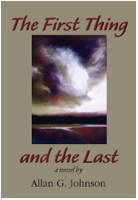Here is Part Two of our interview with Allan Johnson, author of The First Thing and the Last. Part One is available here.

How do you think the novel will help engage other men in efforts to end domestic violence?
I have been pleasantly surprised by the number of men who’ve told me they were awakened by this novel to the reality of men’s violence against women; men who had never understood it before.
I’ve also heard from college professors teaching courses about domestic violence who are assigning the novel so that students can reach a deeper understanding of questions such as “Why doesn’t she leave?” It’s one thing to say, “because she’s afraid” and another thing to draw a reader into a story through which they can feel the fear in the moment when she has to decide.
I see a profound level of unreality in our society about most things that really matter—the recent economic collapse and global warming should remove any doubt of that. Stories that confront us with reality in a beautiful and compelling way can help bring about awareness and change, which is what I’ve tried to do here.
Do you view your book as essential reading for potential supporters of the cause of ending domestic violence?
I think it depends on who they are. I’ve spoken to groups that have included people working in domestic violence programs, therapists, and battered women. Their response was to be inspired because most of the story is about Lucy and Katherine and the struggle to reclaim what severe trauma takes from people’s lives.
At the same time, there is, for example, a nearby domestic violence program with whom I have longstanding ties, that recently held a fundraiser whose appeal to potential attendees was the opportunity to meet local authors of various kinds of books. Tellingly, they did not include my novel—of which they are very much aware—which I suspect is because they don’t want to risk upsetting potential donors with the reality of domestic violence. I imagine they feel caught in the bind of needing to raise money to fund their programs but without calling on people to look at the horror of domestic violence that makes those programs necessary.
Given the graphic nature of the violence which may hit close to home for survivors, do you recommend that they read it, or, do you recommend that people unfamiliar with domestic violence read the book to try to gain an understanding of the realities that domestic violence survivors endure?
I’ve had some very positive responses from women who’ve survived domestic violence, who find in this story confirmation that they are not crazy and are not alone. I received an email just last week from a woman who wrote that she found it healing to finally feel that what happened to her had been acknowledged and understood in a way she hadn’t felt before.
We’re living in a culture of denial that offers almost no recognition of what women in these situations go through—no affirmation or mirroring that says their experience is real. Contrast that to the situation for men who come back from war to a culture full of films and novels that try to portray the reality of what they’ve been through and what it has cost them.
Readers have been telling me that The First Thing and the Last is the only novel they know of that follows the reality of domestic violence all the way through from before it begins to some possibility for healing and a life in the aftermath.
That said, I’m not a therapist or a counsellor and I have no way of knowing how reading this novel will affect a given individual. So it’s not my place to say whether someone should or shouldn’t read it.
How will your book help the cause of raising awareness of and ending domestic violence?
It’s an old and important question—what art can do to help raise consciousness. I spent many years trying to understand men’s violence as a sociologist, a teacher, a writer of nonfiction. Now I’ve turned to the power of story to plant itself like a seed in human consciousness and, in the right conditions, come to life and touch our humanity, making us more receptive to the possibility and the need for change. I believe in that, and that The First Thing and the Last has a role to play. There are many ways of telling the truth, and story is one of them. We need them all.